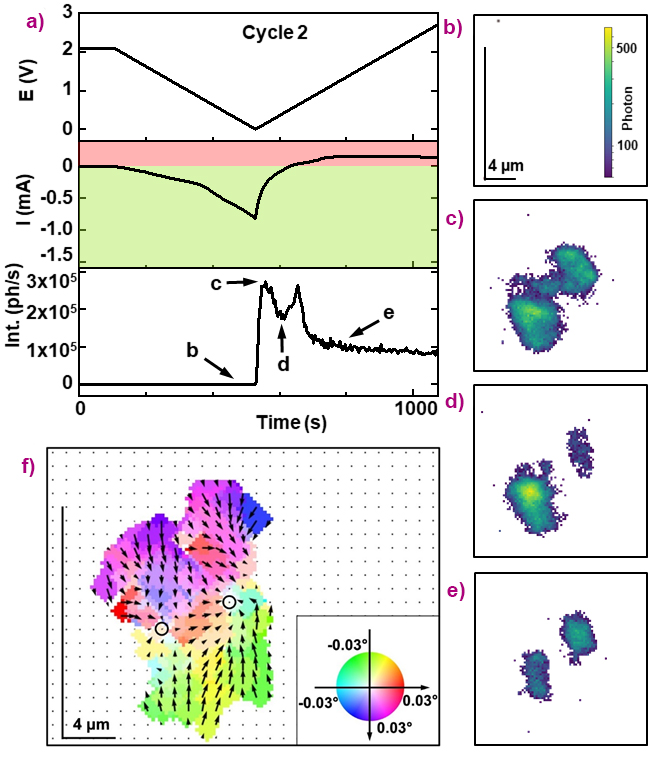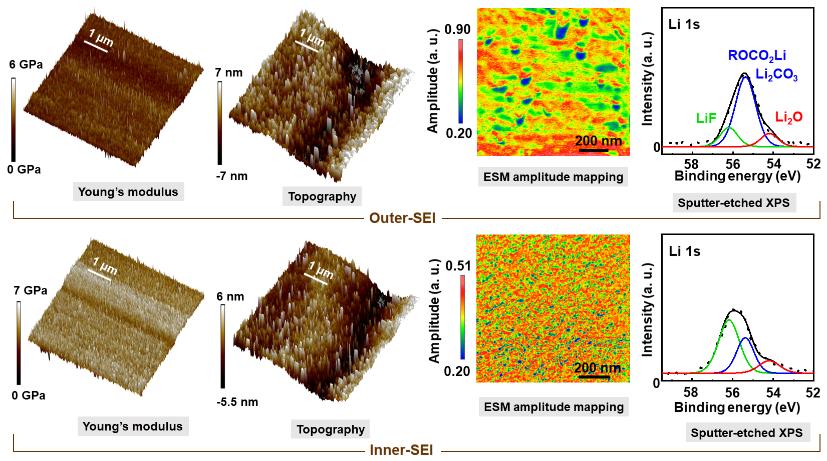- Home
- News
- Spotlight on Science
- Unravelling the...
Unravelling the origin of early-stage defects in silicon electrodes
22-09-2020
Bulk Si electrodes undergo severe mechanical deformation during (de)lithiation. Using operando full-field diffraction X-ray microscopy (FFDXM) on beamline ID01, these deformations were studied in their early stage. Their origin is understood as due to a heterogeneous level of lithiation, correlated to inhomogeneities in the dual-layer solid-electrolyte interphase (SEI).
Share
Silicon is one of the most promising anode candidates for the next-generation of lithium-ion batteries. In terms of specific capacity, Si (3579 mAh g-1) can store eight times more lithium-ions than conventional graphite electrodes (372 mAh g-1). What currently limits its application is the extreme volume change (up to 300%) during cycling, which results in mechanical failure of the Si electrodes. Tremendous efforts have been made to understand the mechanical deformation in Si electrodes. Most of these studies were performed without any spatial resolution, yielding only average information.
In this study, operando FFDXM at beamline ID01 was applied to study the formation of early-stage defects in single-crystal Si electrodes. As a novel strain imaging technique, FFDXM is able to detect tiny mechanical deformations (lattice tilt of ~10-2 mrad and lattice strain of 10-4) at a spatial resolution of 100 nm. The Si electrode potential was scanned by cyclic voltammetry (CV), during which only the Si near the surface participates in the (de)lithiation process and is subsequently amorphised. By recording the dark-field snapshots at −0.03° off the Si (004) Bragg θ angle, the dark-field contrast in FFDXM reflects structural changes in single-crystal pristine Si just below the Si/LixSi interface. Specifically, the scattered intensity is sensitive to any deviation from the perfect single-crystal Si state and thus serves as an excellent measure of structural deformations at the Si/LixSi interface.

Fig. 1: a) Potential (E), current (I) and total scattered intensity (Int.) of the entire area (100×430 μm2) for the second CV cycle. b-e) show the evolution of the observed defects. The labels of (b-e) match the marked annotations in (a), at which the FFDXM images were taken. f) 3D reciprocal space mapping result of the defects at the end of the third cycle.
No defect was observed in the first CV cycle. The only feature was the SEI formation peak in the electrochemistry measurement. Two defects (Figures 1b to e) appeared at the Si/LixSi interface during the second CV cycle, as indicated in the Int. increase (Figure 1a). The nature of these defects was characterised by 3D reciprocal space mapping (Figure 1f) at the end of the third cycle, which revealed that these early-stage defects were dominated by lattice-tilts of as large as 0.03°. The lattices tilted inwards, indicating a smaller lattice parameter at the defect centre, which is characteristic of a heterogeneous degree of lithiation. These early-stage defects, despite their weak deformation and low density, are the seeds of large-scale defects formed after extensive cycling. Understanding the origin of these defects is thus crucial to improving the structural stability of Si electrodes.

Fig. 2: The Young’s modulus, topography, electrochemical strain microscopy amplitude maps and Li 1s X-ray photoelectron spectroscopy spectra of the outer-SEI (top row) and the inner-SEI (bottom row).
The heterogeneous lithiation discovered by FFDXM is an intriguing phenomenon considering that the electrodes were initially atomic-flat single-crystal Si wafers. Since the early-stage defects were only observed after the initial SEI formation, this may point to a possible correlation. To complement the FFDXM measurements, operando atomic force microscopy (AFM), electrochemical strain microscopy (ESM) and sputter-etched X-ray photoelectron spectroscopy (XPS) were performed to study the SEI (Figure 2) and its possible correlation with early-stage defect formation. The SEI layer formed on the single-crystal Si electrode was identified as a complex dual-layer structure consisting of a mostly inorganic (hard) inner-SEI layer and a more organic (soft) outer-SEI layer. Both the inner- and outer-SEI exhibited high degree of inhomogeneities in terms of topography (longer ionic-transportation time for thicker regions), lithium-ion mobility (less conducting for lower mobility) and chemical composition. These inhomogeneities in SEI inevitably led to a heterogeneous degree of lithiation in the underlying Si electrode, which in turn resulted in mechanical deformations upon cycling. This multi-modal study bridges observations in the depth direction across the multi-level interfaces (Si/LixSi/inner-SEI/outer-SEI), thus offering novel insights into the impact of SEI homogeneities on the structural stability of Si-based lithium-ion batteries.
Principal publication and authors
Impact of dual-layer solid-electrolyte interphase inhomogeneities on early-stage defect formation in Si electrodes, C. Chen (a,b), T. Zhou (c,d), D.L. Danilov (a,b), L. Gao (b), S. Benning (a,e), N. Schön (a,e), S. Tardif (f), H. Simons (g), F. Hausen (a,e), T.U. Schülli (c), R.-A, Eichel (a,e), P.H. Notten (a,b,h), Nat Commun 11, 3283 (2020); doi: 10.1038/s41467-020-17104-9.
(a) IEK-9, Forschungszentrum Jülich, Jülich (Germany)
(b) Eindhoven University of Technology (The Netherlands)
(c) ESRF
(d) Nanoscience and Technology Division, Argonne National Laboratory (USA)
(e) RWTH Aachen University (Germany)
(f) Univ. Grenoble Alpes, CEA, IRIG-MEM, Grenoble (France)
(g) Technical University of Denmark, Kongens Lyngby (Denmark)
(h) University of Technology Sydney (Australia)



